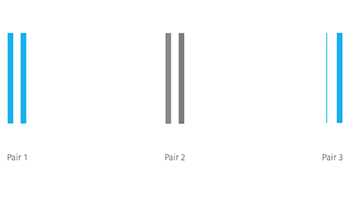
A pattern that is to be formed by a colorant on a substrate is defined in terms of the halftone image that instructs a printing system. This image contains information at each pixel as to which colorants to use at which drop states, i.e., Neugebauer Primaries (NPs) such as CC (two drops of cyan ink) or CM (a drop of cyan and a drop of magenta ink). However, the transformation from this digital input to a final printed pattern involves other steps as well as physical, colorant and substrate interaction effects. An important contributor to the final output is the partitioning of a halftone image into its complementary sub-images that are printed in each pass of a multi-pass or multi-bar printing system (common in inkjet). Typically, great attention is given to the goodness of a halftone image – good pattern distribution, good NP and ink choices – however, partitioning can also have a significant impact on the output both in terms of avoiding unwanted physical interactions (e.g., coalescence, alignment artifacts) and exercising control over the pattern. This can lead to closer correspondence to the halftone and improved print properties (such as grain and robustness) and can be achieved by co-optimizing halftoning (responsible for the spatial distribution of the halftone image) and partitioning (responsible for distributing it among the N passes or bars of a given printing system). The results are not only good overall halftone images as has been the case already, but also good partial halftone sub-images whose gradual printing in different passes results in maximized NP control and thereby its effect on the printed color.

Imaging is enabled by the limitations of the human visual system, which is blind to certain physical differences. The trichromacy of human vision, e.g., allows for very different materials to be combined in a way that results in the same signals triggered by the eye’s cones. As a result a print can elicit the same response as a display, or a projection can yield colors like those in a painting. The limits of spatial acuity too allow for discrete patterns, e.g., those resulting from halftoning, to appear continuous. This paper turns its attention to the limits of color difference perception in stimuli with a very small subtense, such as thin lines or fine features of 3D objects. A first set of psychophysical data, obtained in an on-line visual experiment, indicates a dramatic relaxation of perceptibility thresholds when comparing very thin with thicker lines. The second half of the paper then presents printer imaging pipeline strategies that take advantage of these experimental findings to successfully render fine lines while taking advantage of the more limited sensitivity with which their specific colors are perceived.

As 3D printing becomes more prevalent, more attention is being paid to its ability to adequately reproduce the appearance of surfaces. Research into methods to accurately represent grayscale images through halftoning is well-developed in 2D printing, but work in the halftoning of surfaces in 3D printing is less developed. The halftoning method of tone-dependent fast error diffusion has been shown in 2D printing to be an effective means of achieving both high image quality and computational efficiency, making it an ideal algorithm to run in printing units where computational power is restricted. This work seeks to adapt tone-dependent fast error diffusion to halftone the surfaces of three-dimensional objects. Here, the ideal tone-dependent error diffusion parameters will be calculated for an image. Then, a surface traversal mechanism will be implemented to navigate the surface of a threedimensional object while error diffusion is applied to halftone it. The expected result is an algorithm that can halftone the surface of an object with quality approaching that of iterative methods, with a fraction of the processing that they require. Iterative methods currently produce the highest halftoning quality for 3D surfaces, but their use is limited due to the amount of computation they entail. The development of a tone-dependent fast error diffusion algorithm allows 3D halftoning to represent a continuoustone surface with comparably high quality, but the computation it requires is more appropriate for standard printers; thus, it improves on the quality of surface halftoning that most printing units can produce.

In this paper, we reveal the impact of the fixed synchronization pattern on the halftone image under DBS processing; and an improved watermarking method is proposed to avoid this impact, which is extended from a previously developed DBS based watermarking method. The watermark and synchronization pattern is to be embedded into the appropriate region of the host image adaptively; and excellent image quality and decent watermark capacity is provided. The method has good resistance to a printing and scanning attack while only size of the watermark and host image is required additionally in the watermark detection. Experimental results are presented for some special host images, including a sketch and a round logo to prove the flexibility of the method.